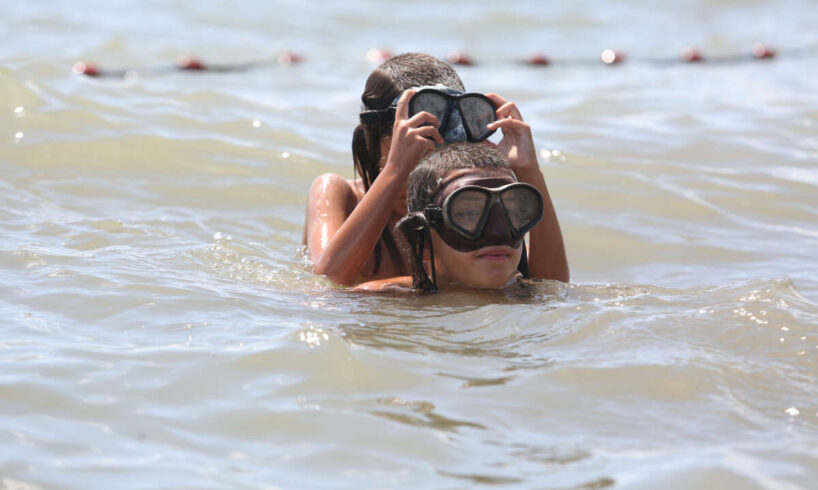
Israel braces for the peak of a severe heat wave Wednesday as temperatures are forecast to reach 108°F (42°C) in the Beit She’an Valley and an extreme 111°F (44°C) in the Arava Desert, with safety authorities issuing comprehensive workplace protection guidelines for outdoor workers.
The extreme heat conditions will affect most regions of the country with temperatures around 104°F (40°C) expected in many areas, prompting official recommendations for protective clothing, increased hydration, and modified work schedules during the dangerous afternoon hours.
After slight relief Thursday and Friday, the heat wave will intensify again over the weekend with potential temperatures reaching 113°F (45°C) in the Arava region, making this one of the most severe summer weather events in recent memory.
Heat wave guidelines and recommendations
The Institute for Occupational Safety and Hygiene (IIOSH) issued several updates aimed at protecting workers whose jobs are outside offices. The institute notes that heat protection includes three stages including appropriate clothing, drinking, and training.
In the area of heat protection, workers are required to wear light, breathable, and sweat-wicking clothing like cotton – and avoid synthetic fabrics as much as possible that limit evaporation and make it difficult for the body to cool down. Personal protective equipment required in some professions, helmets, vests, and additional safety equipment must also be suitable for hot conditions and provide protection without further burdening the body. Additionally, as part of early preparation, workers must be thoroughly familiar with the dangers of exposure to severe heat and the early symptoms requiring immediate response – such as extreme fatigue, confusion, rapid pulse, headaches, or vomiting. Training and instruction on this subject are critical, as early identification of a dangerous condition can save lives.
Additionally, employers are required to take all measures designed to reduce risk. These include installing forced ventilation systems, advance planning of worker deployment so that physical tasks are performed during the cooler morning or afternoon hours, shading open work areas, and reducing physical loads as much as possible. For new workers who have not yet adapted to working in extreme heat conditions, gradual integration must be performed that allows the body to adapt.
Furthermore, strict adherence to shortening direct exposure to heat and radiation, allowing initiated rest periods at regular intervals, and ensuring regular supply of cold water available at all times – while encouraging workers to drink frequently even if they do not feel thirsty.
Scorching heat in the US
The US has also reached the height of summer, and a massive heat dome is forming that will trap sweltering, moisture-laden air and force millions of residents to endure every degree of the oppressive conditions.
A girl on the beach in Israel (Background: Bathers in Tel Aviv) / Photo: xyxy; Yehoshua Yosef
Multiple metropolitan areas may register their most extreme temperatures of 2025 as sweltering conditions develop from southern regions toward the Midwest throughout the week, while moisture levels will drive the heat index – the actual temperature sensation – far into triple-digit territory.
Blazing weather patterns started developing from Gulf Coast areas to Plains states on Tuesday, with more than 60 million residents experiencing heat warnings spanning from Florida to South Dakota, CNN reported. Metropolitan areas throughout these zones, such as Memphis, Atlanta and St. Louis, witnessed thermometers rising into the 90s during Tuesday’s afternoon hours.
The scorching conditions will intensify and spread into Midwest regions on Wednesday. Punishing temperatures will extend from southern states through Midwest areas on Thursday and begin advancing into eastern territories.
Tel Aviv beachgoers (Reuters / Ronen Zvulun)
Wednesday and Thursday may establish new annual temperature peaks in metropolitan areas including Chicago, St. Louis and Memphis, according to CNN. Chicago and St. Louis are forecast to climb into the upper 90s during both days, while Memphis may approach the 100-degree threshold.
The heat index – alternatively called the apparent temperature – will climb to hazardous levels affecting tens of millions in the US during this week, CNN reported.
Heat indices climbed into triple digits throughout southern regions and portions of Central Plains on Tuesday. Temperatures registered as high as 110 degrees along Georgia and South Carolina coastal areas during afternoon hours. By Wednesday, certain Mississippi Valley sections, including Memphis, may experience heat indices between 110 and 115 degrees.





